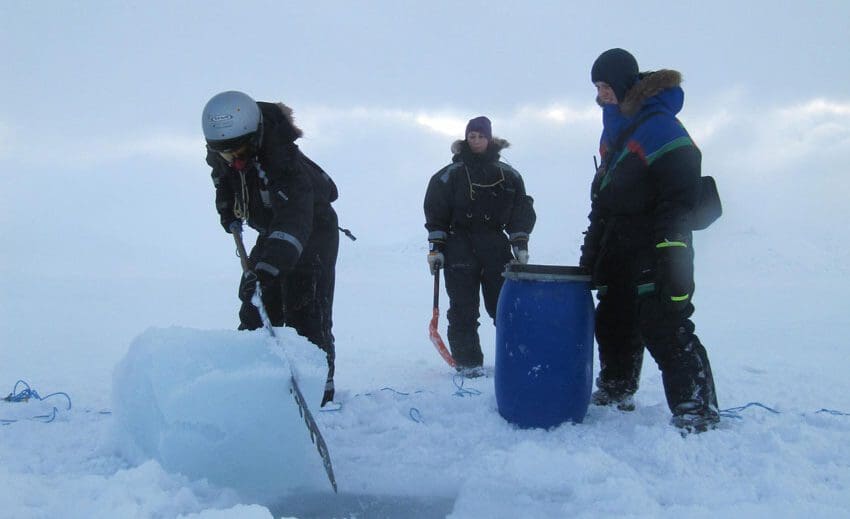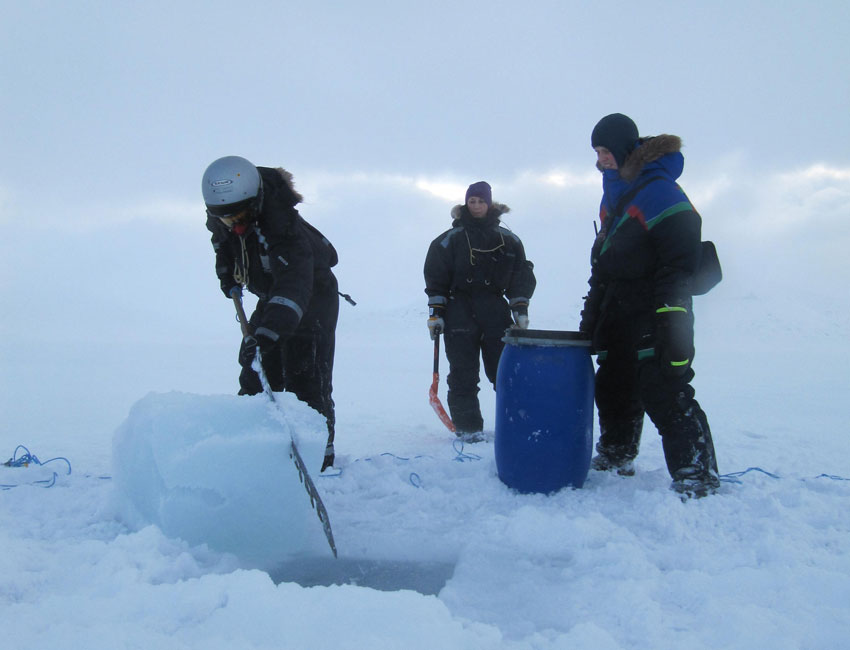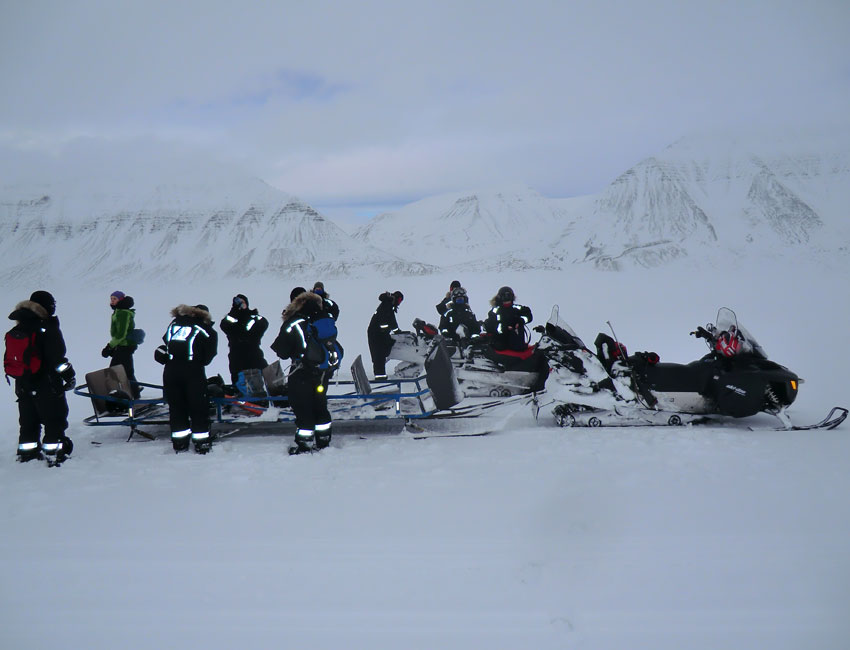AT-824 Detection of Emerging Pollutants in the Arctic Environment (10 ECTS)
ID:
AT-824
CREDITS:
10 ECTS
APPLICATION DEADLINE:
October 15, 2023
START DATE:
April 15, 2024
END DATE:
May 28, 2024
COURSE PERIOD:
Spring semester (Block 3: Week 16-22)

AT-324/824 students on fieldwork in Van Mijenfjorden. Photo: Roland Kallenborn/UNIS.
| Grade: | Letter grade (A through F) |
| Course Cost: | NOK 1000 (5 days x NOK 200 per overnight stay) |
| Course Capacity Min/Max: | 10/25 students (AT-324/824 in total) |
| Credit reduction / overlap: | AT-324 (10 ECTS) |
| Language of instruction: | English |
| Examination support material: | Bilingual dictionary between English and mother tongue. Non-programmable calculator. |
Course requirements
Enrolment in a relevant PhD program. Comprehensive knowledge of organic environmental chemistry and with experiences in chemical analysis or successful participation in AT-831 and AT-830.
Academic content
Today, some of the historical persistent contaminants are on retreat due to stringent environmental regulations. However, a large number of new chemicals have been introduced in industrial applications. Can these contaminants be a threat to the Arctic environment? How can contaminants of emerging Arctic concern (CEACs) be identified. Their fate and transport in the environment from both long-range and local sources are key areas of research in the Arctic Monitoring and Assessment Program. Despite CEACs often being found at low concentrations, they can have a serious impact on the ecosystem. Can we predict their potential threat to the Arctic before they actually are posing a problem? This knowledge is key in regulatory measures that can prevent new problems from arising in the Arctic.
The course will introduce the students to the most commonly used/modern? methods for the preparation and quantification of organic contaminants in samples from the Arctic. Per- and polyfluoroalkyl substances (PFAS) will be a focus area in the course since they have been found in the Arctic in all environmental compartments. What is feasible and what are the limitations and potential confounding factors during sampling and analysis?. The emphasis will be put on a demonstration of methods and a discussion of challenges and pitfalls through practical exercises and experiments with Arctic environmental samples collected during fieldwork near Longyearbyen and at the UNIS field station in Svea. In addition, the course will provide students with an introduction to the modelling methods that can be used to predict if contaminants can become a problem in the Arctic (in-silico assessment).
Active field and laboratory work will demonstrate the importance of sampling/sample treatment as an integrated part of trace analyses, with focus on both abiotic and biotic samples. Samples will be prepared for analysis at the laboratory at UNIS and analysed at NTNU in Trondheim.
PhD students will evaluate the complete process leading from sample site selection, sampling and quantification based upon modern analytical technology and how these data can be used in estimating environmental risk.
Learning outcomes
Upon completing the course, the students will:
Knowledge
- understand the challenges of sampling and analyses of Arctic samples given the often-low concentrations present,
- understand the requirements underlying modern analytical chemical methods for the quantitative determination of environmental pollutants in Arctic environment.
- appreciate the logistical and technological requirements for conducting field work on environmental pollutant research under Arctic conditions.
- understand the role of environmental chemistry in risk assessment of contaminants in the Arctic.
- appreciate the role of modelling methods in determining fate and transport of emerging Arctic contaminants for the overall environmental risk assessment in Arctic environment.
Skills
- be able to make predictions of potential contaminants of emerging Arctic concern (CEAC)
- plan suitable strategies for sampling CEAC in the Arctic environment and perform field work to collect these samples.
- select methods for a sound and reliable determination and quantification of PFAS
- apply uncertainty in the data for the applied analytical methods as a framework for subsequent statistical evaluation and risk assessment.
General competences
- understand critical chemical properties that determine environmental behaviour
- identify appropriate sampling and analysis methods for chemicals of environmental concern.
- provide valuable knowledge as team player for relevant environmental research activities on distribution processes and effects of anthropogenic pollutants in the Arctic.
Learning activities
The course extends over ca 6 weeks including compulsory safety training is run in combination with AT-824.
Fieldwork will include sampling in the vicinity of Longyearbyen (1 day) as well as a stay at the UNIS field station in Svea totaling 5 days.
The AT-824 students will actively participate in field work and laboratory experiments. They will join an assigned student group (together with AT-324 students) and contribute to the laboratory report as a part of the AT-824 compulsory learning activities.
In addition, the AT-824 students must prepare a written comprehensive scientific report on assigned experiments including a scientific literature-based review on fate and transport of contaminants associated to the experiments (4500 words; background, experimental section, results put into a scientific context, motivation, including tables, figures, and key references).
Summary
- Total lecture hours: 30 hours.
- Field work: 6 days
- Laboratory work and modelling: 40 hours.
- Self-study and preparation: approx. 100 hours
- Report writing: approx. 40 hours
Compulsory learning activities
- Lectures
- Seminars
- Field excursions
- Report writing
All compulsory learning activities must be approved in order to sit the exam.
Assessment
| Method |
Percentage of final grade
|
| Written report in manuscript form | 50 % |
| Oral exam (report discussion) | 50 % |
All assessments must be passed in order to pass the course.
Each assessment is graded, and subsequently combined into a single grade. Partial grades for each assessment will be available.
Student life


